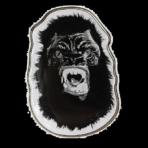Forty years ago, the Museum of Modern Art in New York staged an exhibition called “An International Survey of Recent Painting and Sculpture.” Of the 165 artists included, only thirteen were women, and eight were artists of color. A small group of female artists protested the exhibition, but no one was paying much attention to them. They realized that in order to make any difference about the gender disparity in the art world, they needed to stage bigger actions that would force people to pay attention. The Guerrilla Girls were born.
Over the past four decades, the Guerrilla Girls have remained anonymous. Each member chooses the name of a deceased female artist as a pseudonym, and when out in public for exhibitions, protests, marches, or other actions, each member disguises herself with a gorilla mask.
“We needed a disguise,” one has recalled. ”No one remembers, for sure, how we got our fur, but one story is that at an early meeting, an original girl, a bad speller, wrote ‘Gorilla’ instead of ‘Guerrilla.’ It was an enlightened mistake. It gave us our ‘mask-ulinity.’” (source)
The group used advertising strategies early on to get their points across: catchy, bright posters, stickers, and billboards with humorous text and shocking statistics. They’ve called out specific galleries, artists, and collectors by name. They’ve done museum takeovers, exhibited all over the world, and fearlessly held not only art museums but also politicians, massive cultural institutions, and the film industry accountable for discrimination and abuse.
This fall, the Getty Research Institute will host an exhibition, How to Be a Guerrilla Girl, that will showcase of their extensive Guerrilla Girls archive: behind-the-scenes notes, drafts of posters, ephemera from the group’s work across decades. We spoke with one of the founders of the Guerrilla Girls, who goes by the pseudonym Käthe Kollwitz, about the group’s legacy, the evolution of their work over the years, and what the next forty years of activist art might look like.
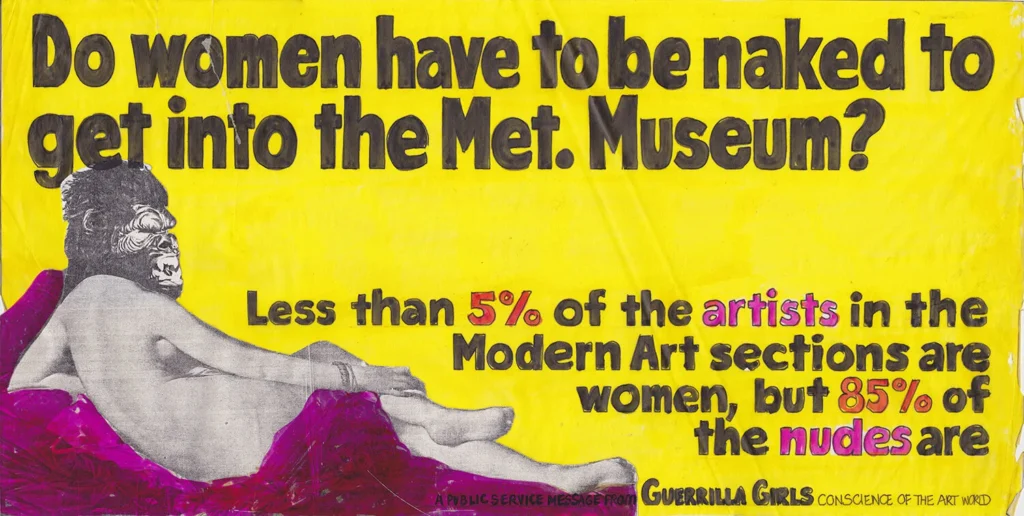
Air/Light:
Thank you so much for doing this interview with us. I’m so excited.
Käthe Kollwitz
I’m excited to see what you’re going to ask, and hopefully give good answers!
AL
So, to start us off: 2025 marks forty years of the Guerrilla Girls, which is incredible. Whenever you hit a milestone like this, do you normally do anything to celebrate or mark the occasion?
KK
In general, no, but we had a big thirtieth birthday party in New York where we did this action at all the contemporary museums, including a big projection on the Whitney, and stickering all over the other museums. There’s actually a film about that, because these filmmakers followed us around. The film is Guerrilla Girls: Not Ready to Make Nice. And we had a party. People came from all over, and one of our favorite curators in the entire world came and DJed. And we did an exhibition of a bunch of our work over those three decades, called The Guerrilla Girls: 30 Years and Still Counting.
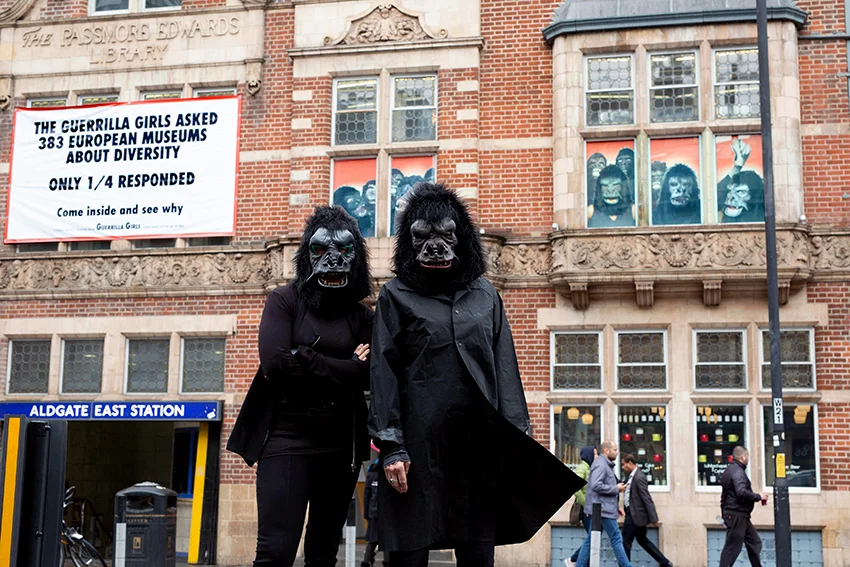
AL
So this year is a little more low-key.
KK
We’re not having an actual party, but we’ve been doing so many projects around the world. It’s cool. It’s amazing. Just to think, the idea to put up one poster on the streets of New York [forty years ago] became this worldwide phenomenon.
AL
It’s incredible! I’m thirty-seven, so I’ve never lived in a world without the Guerrilla Girls. I feel very lucky.
KK
I did live in a world without the Guerrilla Girls for quite a while! But I feel lucky to still live in the world of the Guerrilla Girls.
AL
And speaking of everything you’ve done this year: you were in Bulgaria over International Women’s Day. Can you talk a little bit about that trip?
KK
It was just an incredible experience. You know, there aren’t International Women’s Day events as much in the States, but it’s a huge thing in Europe. And we were contacted by the Bulgarian Fund for Women. They wanted us to come and do a project about Bulgaria, and also have an exhibition in their national museum and march for International Women’s Day. Being in the march was just amazing. Women from all over the world, women who live in Bulgaria, it was quite the experience.
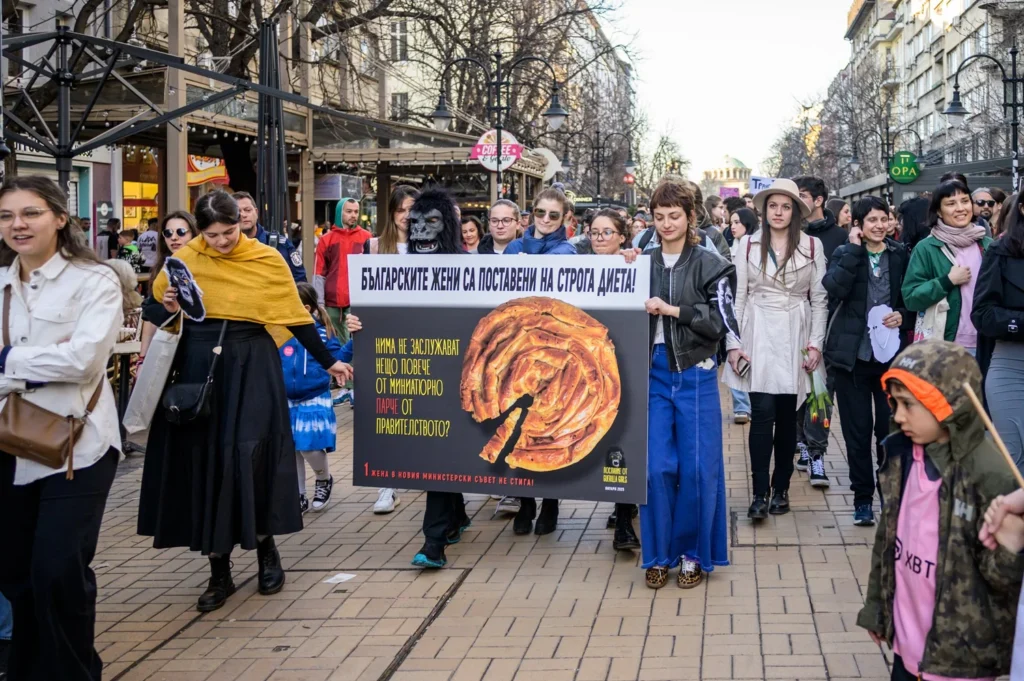
AL
And obviously they already knew who the Guerrilla Girls are, I assume. It wasn’t their first experience with your work.
KK
Yeah, definitely, I mean this thing has built up and exploded for so many decades since we started. And one thing that’s great about doing this work is so many people want to do political art, and many are doing great things already, but they also get inspired by what we do, and that’s the biggest, greatest gift they can give us. And I guess also the gift we give them.
AL
You know, I tried to read through as many interviews as I could before speaking with you, and so I know that people are always asking you, like, how can people join? How big is the group? How do I become a Guerrilla Girl? And you’ve often said that the group mostly wants to inspire people to kind of interpret the work in their own way and carry it forward in their own way. And thinking about that, trying to look ahead forty more years from now, do you think the Guerrilla Girls will still exist in some form? What do you think the legacy will be at that point down the line? I know that’s hard to answer.
KK
I think the legacy will be the fact that you will still be able to see all the work that we did, everything we created. Luckily, we live in a time now where it’s all preserved and documented. And hopefully it will continue to inspire people.
And you know, I think part of the legacy will be the fact that we had this new idea about how to do political art—not that there hasn’t been fantastic political art over centuries—but for us, we really use the persuasive strategies of advertising. Something that disrupts you, tells you something you didn’t know before, and proves it with facts that will make you think about issues differently than you did before. And that’s basically what we’ve played out over all these years in so many different ways. And, okay, some things are more effective than others, but that paradigm that we work under really, really works. The twist is what’s important. You can’t just say this is bad. You have to find another way to break through people’s preconceptions.
AL
I think another large part of the group’s success is because of the humor. The humor has aged well, which… well, a lot of humor doesn’t necessarily stand the test of time. One of the pieces that I’m thinking of is the poster about museum wall text, where you asked how we are supposed to write wall text for an artist who is an alleged or confirmed sexual predator. And you used Chuck Close as an example. The first time I saw it, it just struck me as so darkly funny. Can you talk a little bit about the humor of your work over the years?
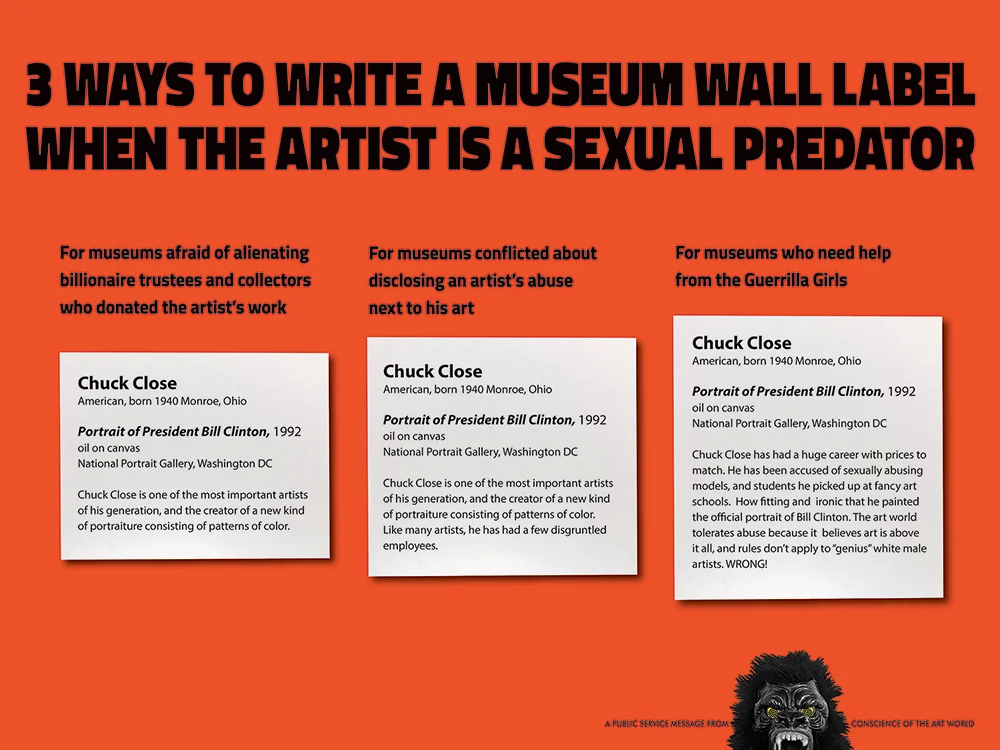
KK
I actually have a Chuck Close story. The Guerrilla Girls were in an exhibition in DC at the Hirshhorn Museum just when Trump was elected, and it was just disgusting being there when [Trump] was there. And when we go somewhere for an exhibition, you know, there are events, we give talks, we’re really busy. But I had one morning off, and I read that it was the first day that they were going to have the Obama portraits in the National Portrait Gallery. So I go over there. There are huge lines of people, every kind of person, every age; everyone’s so happy and they can’t wait to get in. Obama’s portrait was surrounded by all these other portraits from recent times. It’s all chronological. So I go past his portrait and look around the room and I see this Chuck Close portrait [of Bill Clinton]. It was just incredible because the Girls had been thinking about writing a new kind of wall label already. We really feel it’s a good idea to rewrite wall labels. And a lot of museums are doing that now, but this was a bunch of years ago.
But yeah, Clinton, a predator who was painted by Close, who had similar issues with his students and [models]. The poster just went, bam!, it sort of formed in that moment. It was one of those crazy kinds of things. Okay, back to your question.
AL
I love a tangent.
KK
Your question was about humor. I think not all of the work is humorous, but it’s certainly satirical, and humor is a way to disarm people and kind of get them on your side, or at least get them interested.
AL
It also reminds me of—as women, if we’re in a situation, especially with a man, where we feel uncomfortable or threatened, we sometimes try to deflect it with humor, to try to gauge the temperature of the situation, right? So the humor and the satire in the work reminds me of how women have used it as a way to protect ourselves and navigate these situations.
In that same vein, I found another interview that you did with Nadya from Pussy Riot around 2020, and she was talking about Putin using the term “witch” in reference to Pussy Riot’s work. She said, “We need to use magic against Putin; nothing else works.” And it made me think about the so-called “witch hunts” our government is imposing upon women and immigrants right now, and how certain people in power try to use this term “witch” as an insult to talk about women who are voluntarily single, who support abortion, who are very open about these things that don’t fit into the patriarchal system. And it seems like a lot of women are, instead of taking it as an insult, actually leaning into it, and being “witchy” has sort of become a positive thing. So I wanted to ask you about that term: does it hold any power for you?
KK
Well, I guess historically, if you are a woman who speaks up and acts differently than society and men expect you to, you’re a witch. No one’s ever called us witches, but I love it.

AL
I love it too. When I say it, I use it as a compliment, honestly.
KK
It’s about disrupting things, you know, and not just going with the flow and fitting in. And for all of us who are creative people, we want to go against the grain; that’s the whole point. The whole point is to change things, as slowly as it can take, for the better.
AL
And it’s seen the rise of things like—well, you’ve heard of Etsy witches, right?
KK
The what?
AL
Etsy witches. Have you heard of this?
KK
No, no, tell me.
AL
So you know Etsy, the marketplace for creators and things—
KK
Yes, of course.
AL
So now you can go on Etsy and you can buy a spell, or a curse, from a witch. And this came up in mainstream media when—well, after Charlie Kirk was killed, there was this story that someone had hired an Etsy witch to put a curse on him a few days before he died. And so, it’s just so interesting to me, that once again this idea of witchcraft is becoming intertwined with our modern-day politics. And of course, it’s a way for people to blame women for things. If you want something interesting to read, go look up Etsy witches.
KK
That sounds fascinating.
AL
While we’re on Pussy Riot: they have been imprisoned for their work, and now, as far as I know, they are all currently exiled from Russia. Was there any point that any of the Guerrilla Girls felt like your safety was truly at risk, or anytime you almost disbanded because you were worried about your personal safety?
KK
Actually, no. If we’d started today, maybe that would have been a little different. But if you look at Nadya and all the members of Pussy Riot, they had so much guts to do their work in a country where, yeah, they went to jail or were exiled. Thank God they could get out. When Pussy Riot originally started out, you could still do things like that in Russia, because Putin hadn’t gotten total control. It was just a different moment. And the minute that control changed was when they were persecuted and stuck in jail. I mean, they are really brave, really incredible creative artists. For us, it’s not as dangerous, you know, okay, once in a while we get chased or something. But even today, I don’t think with everyone that Trump’s going after, I don’t see him going after us. But I could be wrong.
AL
It’s so scary to think about the moment changing; like you said, there was a point where Pussy Riot could still do certain things in Russia, and then all of a sudden, it was a different moment. It’s impossible not to think: are we at that moment, right before things are going to change?
KK
We are at that point. It’s just a very horrible time in this country. Everything that we fought for our whole lives is being taken away. But we’ve got to keep on going. We always used to say—we still say—just do one thing, and if it works, do another, and if it doesn’t work, do another anyway. And that’s kind of what we’ve done all these forty years. We just keep trying things out, and a lot of them have worked and changed people’s minds.
AL
I know you often do interviews with Frida or as a group, rather than on your own, but I wanted to ask you personally about your own Guerrilla Girls career. When you look back on these forty years, do you have a favorite moment or art piece? Or even top three?
KK
Top three? Oh my God.
AL
If it’s harder than choosing only one!
KK
I would say my favorite thing is always the next thing. It is so challenging, so interesting, to create something that might have this power to change minds. And getting to try new things. The technology is getting better all the time, so we can experiment more with mediums.
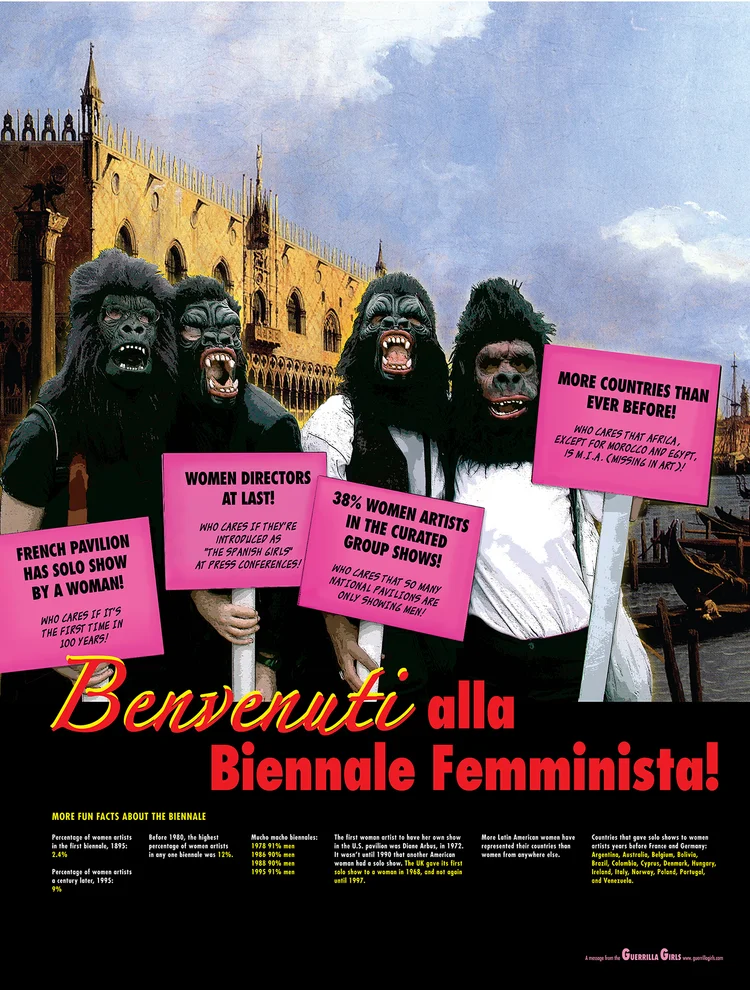
It’s hard to go back through our entire past, but let’s see—one of my favorite things was a long time ago at the Venice Biennale. We worked with the curator, Rosa Martinez, to do one of our first really giant vinyl wraps that we do often now, and we didn’t know where in the Biennale our work was going to be. And when we got there, we saw that she had put us right at the entrance to one of the huge spaces of the Biennale. So, it was like visitors saw the whole rest of the exhibition through those, let’s call it, feminist eyes. It was hugely exciting.
Creating anything is pretty exciting at a certain point. At a certain point, it might be like you want to kill yourself, but at other points, you know, it’s really interesting. And we’ve been lucky that we’ve been able to do so many different things.
Oh, another thing: we also do these “Complaints Departments” all over the world—
AL
I love those.
KK
One thing that I’ll never forget: at the Tate Modern [in 2016], we had a giant Complaints Department. There were billboards all over, you could sit at tables and make things, it was just totally nuts. And this young woman came over to me and said, ‘I have something I really want to put up, but I can’t bear to do it while I’m still here. So, when I’m about to leave, I want to come and give it to you. Will you put it up for me?’ I told her yes, of course, whatever you want, I’m happy to do it. And it was something about this abuse that she had gone through, and it was just heartbreaking, but it was wonderful to see her have this agency in public to declare this. To have a place where she could write anything she wanted.
AL
She felt safe. I think that’s what is so impactful about your work, that you invite people—especially women—to actually participate and to feel empowered in a public space.
KK
Absolutely. That’s what we want.
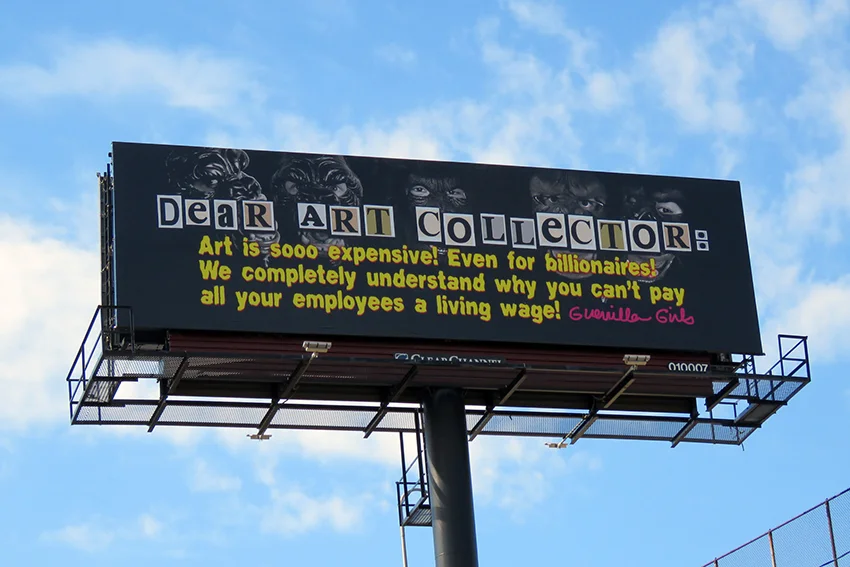
AL
I want to ask about your preparation for protests and actions. Are they always planned pretty well in advance, for instance to mark a certain occasion like International Women’s Day, or did you have any actions that were very spur of the moment, where you just thought: this is happening and we have to do something about it?
KK
These days, museums often ask us to do a special project about them, but we’re still doing other actions and artworks just to do them, which we’ve always done. We’ve just tried to explore things. And a lot of times it doesn’t work, and a lot of times it does. But even the more planned things, we try to do something different each time. So if someone comes to us with a specific idea, but we’ve already done something like that, we often come back to them with a different idea.
We did a project with the Korea Democracy Foundation about women in Korea. Young women in Korea are angry. They don’t feel that they’re getting ahead. Some young women don’t want to have children because of the political and social climate, and their personal rights. So it’s been a big thing there.
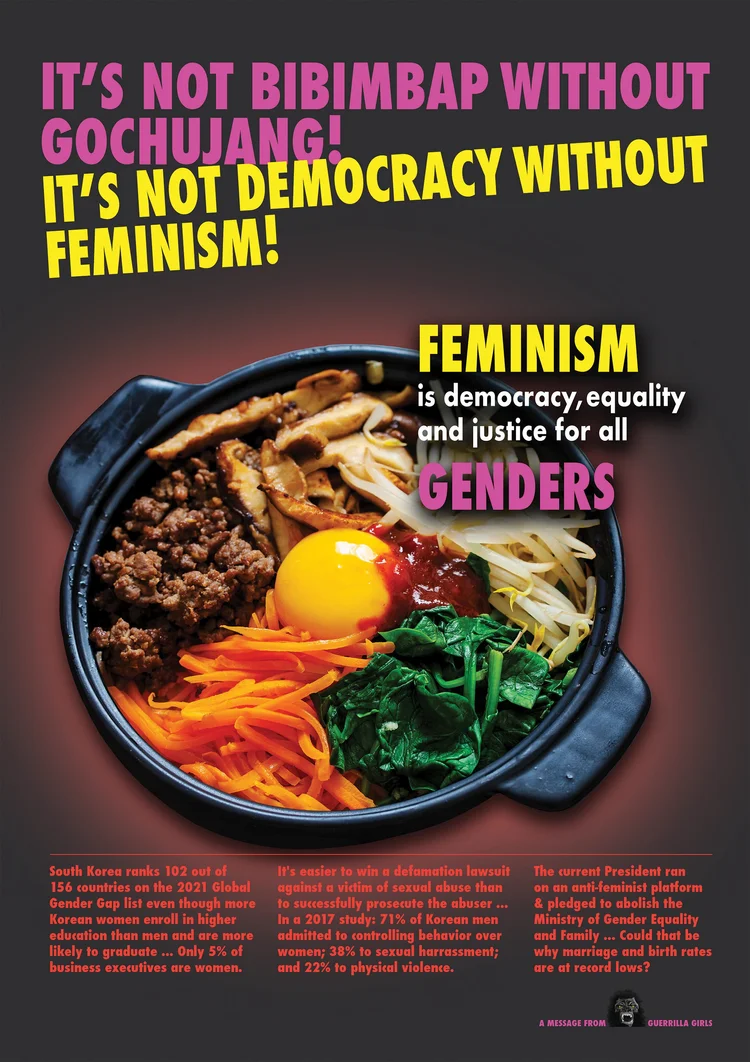
AL
Do most of the Guerrilla Girls’ actions come into being that way, when an organization invites you and proposes a project?
KK
We get invited to a lot of places, and people want us to make trouble there. This upcoming Getty show is really the Getty Research Institute’s exhibition. The exhibition will consist of their Guerrilla Girls archive. But of course, since we like to make trouble, we’re doing a huge mural in the lobby of the Getty Research Institute, which is kind of an attack on J. Paul Getty’s art collection, and also about violence and nudity in our culture over the centuries.
AL
You read my mind. I was going to ask if you were planning anything to coincide with the Getty exhibition, because I know in the past you’ve worked with museums and institutions to criticize their collections or practices, and show them how they can do better. Will the lobby takeover last for the entire duration of the exhibition, or just for the opening?
KK
The whole time. It’s kind of like a cartoon. The paintings will kind of come to life and the models and mythological creatures in the artworks will talk about themselves, the work, critiquing and commenting. The title of the project is “Guess What the Guerrilla Girls found in these old “Masterpieces.” It’s going to be wild. I hope other people think it’s wild.
AL
Oh, I’m so excited. Is there anything in this exhibition from the Getty archives that the public hasn’t really had access to before?
KK
There are some preliminary sketches, notes that show us trying to work out certain pieces. One of our most well-known posters, our very first poster, was called “What Do These Artists Have in Common?” It was a list of some of the most famous artists of the time, a black and white poster. The first thing we put on the street. The subhead was: “They allow their work to be shown in galleries that show no more than ten percent women artists.”
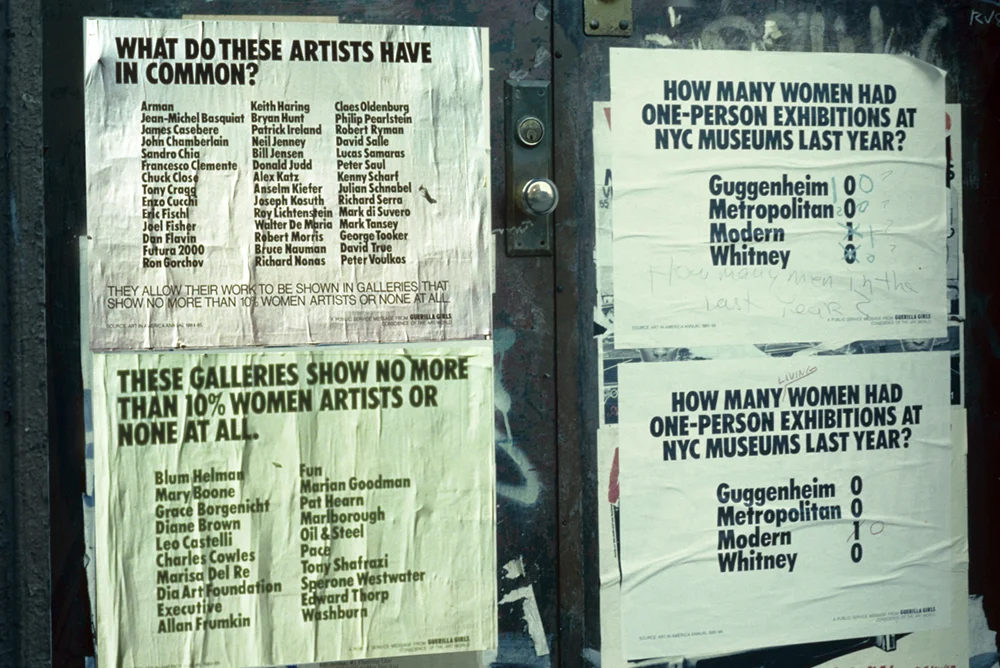
And then there’s our other really well-known poster: “The Advantages of Being a Woman Artist.” Okay, so, in the Getty exhibition, there will be lists we made while designing the concept for this poster, writing out all the advantages of being a male artist versus the advantages of being a woman artist. At one point in the process, it just became so clear that the poster had to be titled “The Advantages of Being a Woman Artist,” but that all of the items listed underneath would be disadvantages. And that’s what made the poster so great. It’s a game-changer. That’s what we look for every time we create a poster and every time we create something new.
AL
It’s so iconic. I’ve been an artist my whole life, and the number of “The Advantages of Being a Woman Artist” items I have been given—I could open my own merch store. I love it. I’m always happy to receive another one. That work might have been my introduction to the Guerrilla Girls years ago, but it also might have been that piece you did with Carl Andre and O.J. Simpson, because Ana Mendieta is one of my favorite artists.
KK
Oh really?
AL
And it’s also been about forty years since she died. She died around the time the Guerrilla Girls formed.
KK
Yes, oh my goodness, yeah.
AL
I was on Twitter the moment it was announced that Carl Andre died, and every single person I was following, and all the media, my entire newsfeed: everyone was only posting about her. No one posted anything about him or was saying his name, but we all knew why all of the Ana tributes were appearing. It was so satisfying. It was essentially a whole memorial to her.
KK
That’s such a great thing to happen, because usually it would still be all about him, and she would barely be acknowledged.
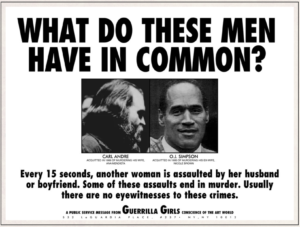
AL
I thought of the Guerrilla Girls immediately when that happened, not only because of that poster, but it just felt like this big moment of the public coming together and refusing to honor this man by speaking Ana’s name instead. Do you think she would have been a Guerrilla Girl?
KK
Oh, that’s a good question. She might have, but I don’t know if she would have wanted to be a Guerrilla Girl because she was so focused on her own work. Not that members of our group weren’t also focused on our own work, but…
AL
I know what you mean. Are you allowed to give a loose number of how many members are in the group today?
KK
Well, here’s our secret. To do the kind of work we do, you cannot be a huge group. So, while we’ve had over sixty members of the Guerrilla Girls over these past forty years, it was never sixty at one time. I don’t think there’s a need to say exactly what “small” means, but that’s how you can get things done. There were a few times when we were really large and it was just impossible.
AL
Is there a Guerrilla Girls text group? Like a group chat?
KK
No. Well? No. Well—I— (laughing)
AL
(laughing) I’m just asking because I feel like group chats are having a moment for female friendships and female communities right now. It’s this little safe spot for women to converse and confess without men around.
KK
That’s so fantastic. In a way, we do that, because we’ve often worked remotely. We always had to use whatever technology there was to kind of make our own group chat.
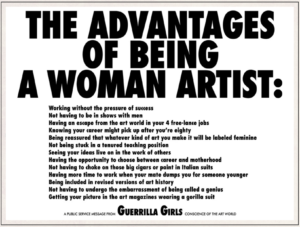
AL
All right, we’re getting close to our time, and I know you have to go finish setting up at the Getty, so I have one last question for you.
KK
Sounds like it’s gonna be a hard one.
AL
It actually might be. So, going back to our earlier conversation about rewriting wall labels—if you had to write a wall label to encompass the past forty years of the Guerrilla Girls career, what are three words you’d use within that text to describe your efforts and your legacy?
KK
Oh my God, can I think about that?
AL
Absolutely. Just three key words. You can interpret that however you want.
KK
Wait—okay. I have three words. The three most important words to me are: don’t give up.
AL
Don’t give up.
KK
Keep on trying to push that rock up the hill.
AL
That’s all we have, right? We’ve got to keep going.
KK
Especially now. Our fight is not over. It’s a very tough time right now, but we are not stopping.
AL
We have the numbers. There’s a lot of us.
KK
Yeah, thankfully. There’s a lot of us.
More information about the Getty exhibition, How to Be a Guerrilla Girl, here. All images included in this interview © The Guerrilla Girls.
